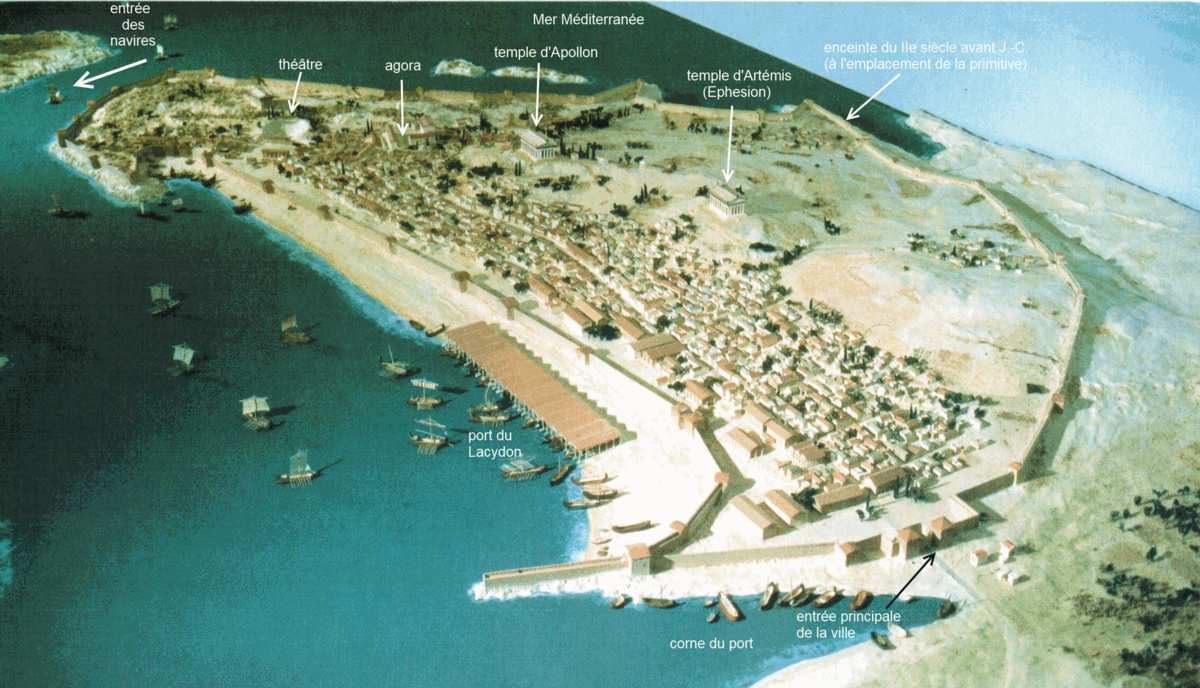|

It is interesting that from 800 until approximately 400 BCE many Greek colonies were established along the Mediterranean region. One of the most important western ones, however, was Marseille, or as it was then called, Massalia. In ancient Greece, it was common to create myths for great events, and Massalia has its own legend explaining its founding. In 600 BCE, a group of Greeks from Phocaea (a Greek colony in Minor Asia) were sent to find a site to create a new city in order to relieve Phocaea from overpopulation. With Protis being the chief of this expedition, they reached the area of South France, and more specifically, the cove of Lacydon. The site belonged to a Lingurian tribe whose king was Nannus. Protis asked his daughter, Gyptis, to marry him and this is why they say that the city was born out of love. The couple moved to the hill in Lacydon, signaling the inception of Massalia's history.
Massalia, occupying an area of 125 ha, was, as almost all Greek colonies, a fortified port city. The Phocaeans took advantage of the amphitheatric morphology of the cape, situating the port at its southern part. The settlement extended along the Lacydon port, providing with a southern orientation for the houses and the public buildings (Orientation was an indispensable planning tool for all ancient Greek cities. This can be also observed by examining the database entries related to the Greek civilization). The hippodamian system was not yet introduced, but one can see from the model of Massalia, that the urban layout is based on the grid. We need to clarify that the whole analysis is based on the model made for the ancient city of Marseille. By observing it, we can also identify, mainly due to the width, one main road dividing the city in two. This road, which was parallel to the port, stretched from the main entrance of the city until the agora space which was located at the other side of it.
Close to the agora, where most of the public buildings were usually located, was also the space of the theater. The acropolis was related to the main sanctuaries of the city, the temple of Artemis (Ephesion) and the one dedicated to Apollon Delphis. These are the main urban elements that can be identified in the model of the city. It seems that the archaeological excavation still goes on, trying to reveal the many different historical layers of Marseille.
The Greek past of the city, which was believed to be simply a myth, was revealed relatively late. The fact that part of the ancient city was bombed in 1943 by the Germans, turned the excavations even more difficult. Meanwhile, despite the fact that, “toute la ville grecque etait la, sous nos pieds. Il y avait la l'equivalent de Pompei”,1 the impact of the war, along with the Marshall treaty, forced into fast reconstruction.
What was confirmed through the excavations, was the importance of Marseille as a trading port city. For many years it retained strong economic links with Greece, as well as Phocaea. From the moment that Phocaea was destroyed by the Persians, though, the main focus was given in establishing good trading relationships with the Romans and the western mediterranean region. After allying with the Roman Republic, the city's economy thrived by exporting Roman goods to France and new products, as well as slaves, to Rome. Despite the alliance, however, the city was involved in civil war, resulting in its becoming subordinate to the Roman empire in 49 BCE.
Footnotes : 1.Laurent Ribadeau Dumas, "Marseille, cité grecque". Published on 25/02/2010, 23:05. [online]. Available from : http://culture.france2.fr/patrimoine/dossiers/marseille-cite-grecque-22320253.html .Accessed : 20/05/2011
source: 1. Wikipedia. Vocabulary entry : Marseille. Accessed : 20/05/2011
2. "Marseille cité grecque", published in Institut National de recherches archeologiques preventives, on 30th September 2009, code FB21083501. [online]. Available from : http://www.inrap.fr/archeologie-preventive/Actualites/Actualites-des-decouvertes/Archives/2006/p-1088-Marseille-cite-grecque.htm .Accessed : 20/05/2011
3. Massalia. [online]. Available from : http://college.belrem.free.fr/grec/colonies/massalia/massalia.htm .Accessed : 20/05/2011
4. Laurent Ribadeau Dumas, "Marseille, cité grecque". Published on 25/02/2010, 23:05. [online]. Available from : http://culture.france2.fr/patrimoine/dossiers/marseille-cite-grecque-22320253.html .Accessed : 20/05/2011 |
|

